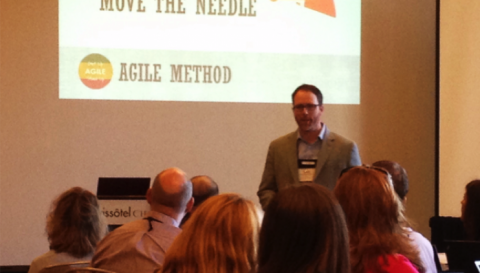
Imagine standing before a room full of your peers and colleagues – many, if not all, of whom have a vested interest in what you’re about to say. Your project team is armed with slides, possibly containing videos or role-playing scenarios.
You have five minutes to introduce your project and to convince the audience that your idea to impact higher ed is a viable one. The clock is ticking.
Welcome to Pitch Day at EDUCAUSE’s Breakthrough Models Academy.
The onsite convening in Chicago culminated in Friday’s Pitch Day, which featured a series of elevator pitches by each team on their higher ed project. The projects, which focus on new business models, student retention and degree completion, faculty roles/development and competency based education, will be developed over the course of the next year. (The most promising projects will be invited to present at the 2016 EDUCAUSE Learning Initiative Annual Meeting.)
Teams are comprised of higher ed leaders whose roles often incorporate pedagogy and ed tech: professors, deans and technologists who manage eLearning, digital curricula and other campus innovation initiatives. Participants are invited to challenge traditional thinking and design of higher education models.
On Thursday, I offered teams a few pointers in my presentation on delivering pitches. Here are some key points to remember for your next pitch:
- Start with the end in mind and work backwards. What is it that you want people to understand? What are the key takeaways of your project, and how can you best emphasize them?
- Know your audience(s). Jump into the viewers’ shoes and ask yourself “what’s in it for me?” What message and medium might best resonate with them?
- Think like a reporter. Answer questions about your product or service, addressing ‘who’, ‘what’ and ‘why,’ and you’re halfway there.
- Minimize jargon use and keep your narrative concise. What are your ‘expert blindspots’? Avoid making assumptions about what your audience’s technical knowledge.
- Injecting creativity will make you memorable. Whether your team is telling a story, role-playing a student scenario or showing a dashboard tool mock-up, adding a personalized touch can make a lasting impression.
While the onsite portion of the program may have ended, the Breakthrough Models Academy is far from over. Teams aiming to develop their projects will work with executive coaches throughout the coming academic year; we’ll keep you posted on their progress.
--
Hungry for more fresh thinking in higher ed? Check out the 2015 Breakthrough Models Academy kickoff blog post to learn more about this year’s program. And visit our blog next week to find out about our program exclusively designed for institutional leadership teams: the 2015 Breakthrough Models Incubator.
